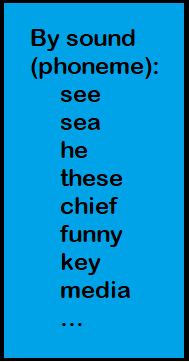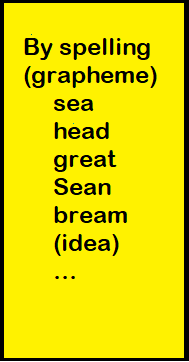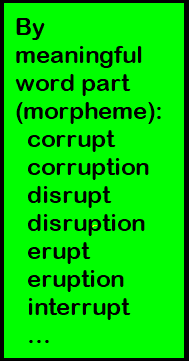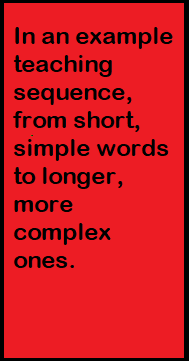Please note that these lists reflect general Australian pronunciation. Click on one of these boxes to see words sorted…




Note that words can sometimes be segmented more than one way,
- e.g. buy = bu + y (with bu as in build, buoy) or b + uy (with uy as in guy)
- waste = w + a + s + te (as in route, torte) or w + a…e + s + t (as in same, take).
My aim has been as few categories as possible. If you find something in this system that’s not as compact as it could be, please let me know.



I would early like some strategies to assist children spell accurately.
Hi Patricia, I think the main things to do are be aware of what spellings they know and don’t know, and then systematically work on a sound or spelling pattern at a time, working from short to long words, getting them to say every sound as they write the relevant letter/spelling, so that they have simultaneous sensory feedback from ears and mouth about the sound, and eyes and hand about the letters. They need to learn to habitually stretch out spoken words and listen to their own mouths as they say words, and segment them into sounds, and learn the various ways each sound can be spelt, including the funny/tricky spellings. I use a lot of sorting and lists, because once you have a good list of words with a shared spelling pattern you can eyeball it and see what kinds of words use that pattern, and where in the word it is used/what other spellings it goes with. Then with long words they need to develop a posh “spelling voice” which pronounces words as they are spelt, with stress on every syllable and for irregularly-spelt words, funny pronunciation e.g. “bus-i-ness” ie saying these words the way they are spelt. Hope that’s useful, Alison
Hi Alison, I think the main things to do are be aware of what spellings they know and don’t know, and then systematically work on a sound or spelling pattern at a time, working from short to long words, getting them to say every sound as they write the relevant letter/spelling, so that they have simultaneous sensory feedback from ears and mouth about the sound, and eyes and hand about the letters. They need to learn to habitually stretch out spoken words and listen to their own mouths as they say words, and segment them into sounds, and learn the various ways each sound can be spelt, including the funny/tricky spellings. I use a lot of sorting and lists, because once you have a good list of words with a shared spelling pattern you can eyeball it and see what kinds of words use that pattern, and where in the word it is used/what other spellings it goes with. Then with long words they need to develop a posh “spelling voice” which pronounces words as they are spelt, with stress on every syllable and for irregularly-spelt words, funny pronunciation e.g. “bus-i-ness” ie saying these words the way they are spelt. Hope that’s useful, Patrica
Very very nice
I have just found your site and it’s wonderful. I want to figure out an approach for a year 7 class. They come from varied backgrounds, and are not bad but not confident, I need something that is methodical and going to work ‘en bloc’. I realise it’s not ideal but there you are. Which of your three approaches to lists do you recommend ?
Thanks for the nice feedback. My site needs a lot of work but I haven’t got a lot of time to do it! Hopefully I’ll get the main things done in the next school holidays. The first two of the three lists are intended for parents/teachers, to let them look up a sound and find all its spellings, or look up a spelling and find all its sounds. If you are looking for lists of lists to use as spelling lists or as the basis of spelling activities like wordsearches, worksheets or crosswords, try the third set of lists, as they are arranged in order from short to long words and from simpler to more complex spellings (though what is more complex than what is a bit arguable). They aren’t a spelling program though, involving a variety of activities. But I guess if you have the target words you can always find/make activities.
I love your site I homeschool my daughter and we love to look through your site and find interesting things to study
Hi Alison – A teacher was asking about the word negotiate? Is the letter t representing the /sh/ sound. We know many words have ti for /sh/ but in this word we hear the letter i representing /ee/. Wondering if you can shed any light?
Hi Chris, yes, there are a few words that represent /sh/ with a letter T, see this list http://www.spelfabet.com.au/spelling-lists/sorted-by-sound/sh/t-as-in-initiate. Of course we all got a little confused about this when Julia Gillard was PM, as The Chaser pointed out here: http://www.youtube.com/watch?v=CQbQzKyi1FM
Hello! A question re adding the suffix ‘es’ to pluralise words ending in ‘o’ such as ‘echo/echoes’ and ‘hero/heroes’. Is the long vowel sound in the plural form of these words, made from just the ‘o’ or does it change to coming from the ‘oe’? Likewise, when suffixes are added to words containing split diagraphs e.g. ‘dispose/’disposable’ and ‘code/coding’, does the long vowel sound remain from the split digraph in the base word, or does it change to just the ‘o’? I’m thinking the long vowel sound remains linked to the base word, but is this correct? Help!!!
Hi Amanda, I’ve been trying to grapple with this issue myself, and my best answer to it so far is that words have several layers. They have a phonological layer and a morphological layer, and these often both appear in the orthographic layer. So in ‘echo’, you could say that the o changes to oe in the suffixed form (which makes sense at a phonological level) or you could say that the o stays the same and the suffix is “es” (which makes more sense at a morphological level). The same for split digraphs like in dispose/disposable, actually linguists would probably say the stem is “dispos” as that’s what doesn’t change, and we signal the vowel sound with an “e” in the base form and drop it before adding vowel suffixes. I used to be fairly focussed on the phonological level as my clients were mostly real strugglers who weren’t yet dealing with long words, but now I work with a lot more older kids who need to learn about word parts, and am more inclined to tell kids about all the relevant layers. Learning about the sound-letter relationships and also the meaningful word parts, and how these affect a word’s spelling, is all good grist to the remembering-the-spellings mill. Hope that makes sense! All the best, Alison
Hi Alison,
Thank-you for your very helpful website. I am wondering whether there are any good spelling interventions for a Year 8 girl who is otherwise performing very well academically but her spelling is keeping her back.
Any advice would be very helpful
Esther
Hi Esther, yes, there are plenty of good spelling interventions available but the first thing you need is a good assessment to see what she does and doesn’t know, so you can fill gaps and then build her knowledge. Usually older students’ errors are quite a mixture, but there are a lot of vowel errors, and lots of confusion over things like doubling consonants (e.g. run-running), dropping e (e.g. hope-hoping) and changing y to i (e.g. happy-happiness). Sometimes these things are and errors are more to do with building long words using prefixes and suffixes. Can you have a look at That Spelling Thing? This is an approach rather than a program but it might give you the logic/strategies you need, see https://thatspellingthing.com. If that doesn’t seem suitable just email me with a bit more detail and maybe an uncorrected writing sample, and maybe I can think of something else. Alison
I have used the THRASS methodology for many years. It is a British-based programme for Teaching Handwriting, Reading And Spelling Skills. Check it out!
Hi Jan, I am aware of THRASS, and perhaps it’s used differently in the UK from how it’s used here, but I’m not a fan. See https://www.spelfabet.com.au/2020/09/thrass-the-phonics-of-whole-language
Hi, Love your website and resources. I have a kindy background but have moved into tutoring using sounds write. I have learned so much but approaching spelling still has me a bit stumped as to the best way to structure the program (especially for the kids who are great readers but can’t spell). If I am teaching /ae/ spellings, I explicitly teach all the spellings at once. But what is the best way to structure the student’s practice – focus on a small group of words with mixed spellings or focus on a group featuring one spelling at a time? How many words is reasonable? If I am seeing them once or twice a week, how can I get sufficient coverage/practice to ensure retention without it needing weeks to cover a single sound? Any tips or directions you can point me in would be much appreciated.
Hi Louise, this is a bit of a vexed question, I think, as it really depends on the learner. Younger kids and kids with very low phonological memory and rapid naming skills, or lower language and/or cognitive skills, or who are having a lot of difficulty with handwriting or articulation, tend to need a slower, gentler introduction to new patterns and more repetition than typical kids. I really like the program Sounds Write but find that the start of their Extended Code work has too many spellings at once for many of our clients, many of whom have additional diagnoses and/or poor phonological awareness. It also really depends on how much homework they can do, a child with lots of additional needs but a really well-organised family and the habit of doing a little bit of work every day can really surprise us with how much progress they can make, especially if we can find books that they love. My main tip is to do as much writing-while-saying-the-sounds as possible as that seems to be the strongest glue in terms of activities. Hope that’s helpful, all the best, Alison
Thanks Alison,
Some really useful food for thought here – and yes, all our strugglers are so different. There is certainly no one size fits all! I am trying to build up lots of word wall activities (never knew it existed until you posted about it, so thanks for that!) to reinforce spelling, but I am glad you reminded me that the writing while saying the sounds is key! I think sometimes all the letter tiles get in the way and I forget that! Thanks
Hi Alison
I’ve visited your website several times over the years and love it, thank you. I’m about to introduce my EFL kindergarten day students to spelling. I’m mindful that a lot of practices in education are just done because others do them, and they are not always either best practice or sometimes even good practice. The Asian education culture is based around memorisation and rote learning and they need to memorise spelling words. After the first semester the list, is chosen by the school around their EFL textbook, but in the first semester I can choose whatever I think is best. I would be grateful if you could provide a suggestion as to how I can support them to learn those words (e.g. rainbow writing / look cover write say type tools?). (I’m thinking of easing them in with some simple sight words (so they can construct sentences) and some simple CVC/CCVC words so that they have quick early wins because many words they will learn will be easily able to be sounded out, and a few high frequency words (not sure what they’ll be yet). Thanks for your input, in advance.
Hi David, I suggest you just choose an explicit, synthetic phonics teaching sequence, which will include high frequency words as well as decodable words, and stick to that, rather than trying to invent your own teaching sequence. A surgeon doesn’t have to make his/her own scalpel, just choose one that’s been thought through properly already. Here are some example sequences: https://dsf.net.au/CMSPages/GetFile.aspx?guid=7ce6a8da-6f3e-418c-ac2f-13e7a86dc44a. I also wouldn’t bother with rainbow writing or other visual strategies, the focus should be linking the phonemes (what kids say as well as hear) to the graphemes and word meanings. I hope that’s helpful and makes sense. All the best, Alison
Hi Alison,can you say how many students per session should we have for a remedial reading programme? Given the fact that the pandemic has caused learning loss.
My understanding of the research is that a ratio of up to four kids to each adult is the best way to get good results.
Hi Alison,
Thank you for the wonderful resources you have provided on your website. I’m a parent of Year 1 child who is a fantastic reader (advanced) but his spelling is not anywhere near the same level as his reading. He mostly spells. I want to set up some time daily with him, focussing only on spelling but finding it hard to figure out where to start from. I used to get dictation as a child (schooled overseas where English was second language) but I’m interested to know if there is a more effective way of helping him to remember, any processes, methods that could build a good good foundation. Also heard about spelling mastery program from some other parents on social groups. What are your thoughts? Thanks in advance
Hi Aakanksha, Sorry that I can’t give you a professional assessment or recommendations without seeing your child, you might like to try my free Low Frequency word spelling test, and then work on patterns that seem to be missing in your child’s repertoire, see https://www.spelfabet.com.au/materials/low-frequency-spelling-test. However, I’d recommend taking your child to see an expert for a proper assessment and detailed recommendations, as you don’t want to waste time working on patterns that are already established, or start working on difficult things when simpler things are not yet in your child’s repertoire. Usually in Year 1, vowel spellings are the tricky thing, but some children have other difficulties, so it’s best to get a proper assessment. Sorry that’s probably not the answer you wanted to hear. Best wishes, Alison Clarke
Are your lists available in printed form?
I have a free downloadable booklet of lists, though it doesn’t include every word on the website lists: http://www.spelfabet.com.au/materials/spelling-sorted-2, and it doesn’t include morpheme-based lists. Is that useful?
Hi Alison,
Thanks for all the resources and knowledge you have provided! I have a question regarding an encoding assessment/dictation in the classroom setting. After a stage has been taught we administer a dictation or words for students to spell to assess if our teaching has been successful/areas to continue to work on. It is my belief that when you ask a child to spell a word you don’t sound it out for them as that’s taking a lot of the skill away if you produce the phonemes rather than just say the word? Is that what you think? I was wondering if you had any research or readings that outline how to administer encoding assessments.
Thanks so much
Hi Bethany, that’s a very good question, administering a spelling assessment by segmenting the words, or by pronouncing the words as they are normally pronounced rather than using a ‘spelling voice’ (Wed-nes-day, butt-ER, act-OR etc) makes a big difference to how many words children get right. I am not sure that anyone has actually studied this, I don’t recall reading anything. I will ask John Walker when I next see him, as in the Sounds-Write program a ‘spelling voice’ is one of the things we use to get kids to remember spellings, I think Diane McGuinness referred to this strategy in her books, and from my observation it is how good spellers remember unstressed vowel and many unusual spellings. I always say bus-i-ness to myself when I write the word ‘business’ as I spelt it incorrectly as a child. Thanks for getting me thinking about this! You might also like to ask this on the DDOLL or SpellTalk lists? Alison
Thanks for your continued work on sequential explicit synthetic phonics, Alison. I am always a fan of what you do! I have loved using Little Learners Love Literacy and your resources in my preschool (Pre-Prep program). I am just sad that literacy to this degree isn’t taught in more preschools with teachers tending to shy away from it not realising that it can be so engaging with the children absolutely loving it; not to mention the preparedness for school and the ability to pick up on any possible phonological awareness needs before they manifest.
Hi Keryn, thanks so much for the lovely feedback, great to hear that you’ve had good success, and don’t despair, the Reading Science snowball is rolling down the hill now and it’ll get to preschools soon. Preschool teachers will all be teaching oral blending and segmenting, so children are aware that spoken words are made of sounds, and ready to learn that we represent them with letters when they start school. Your students are lucky to have you ahead of the curve (if I can mix my metaphors). All the best, Alison
These lists are the gift that keeps on giving! So far have been drawing on the ‘By Sound’ vowel lists to work up vocab lessons for my adult ESL students. The only thing is these lists are so comprehensive that I have to cull them so as not to overload learner brains!
Hi Alison,
Can you explain split-vowel spellings a_e, o_e etc versus ‘silent e’ or ‘magic e’. I’m confused!
Thank you for your time.
You’re confused because it’s a bit confusing! The more I work with this part of the code, the more I think we should be teaching consonant-e spellings rather than talking about split/magic/bossy/silent spellings, but I have not had a chance to completely revise my lists to this way of thinking sorry (COVID then two bereavements and their consequences have kind of wiped me out in the last four years). There are lots of consonant-e word-final spellings, in words like voice, large, bottle, leave etc, so if we just add to them we can stick to left to right logic and tell kids that e.g. ke follows the “long” vowels in words like ‘bake’, ‘eke’ (out a living), ‘like’, ‘poke’ and ‘Luke’, whereas ck follows the “short” vowels in ‘back’, ‘neck’, ‘lick’, ‘pock’ and ‘luck’ (but I don’t say ‘long’ and ‘short’ vowels to kids unless they know these terms from school). However, in the program Sounds-Write, which we use at my clinic, they do still talk about ‘split’ spellings, but from discussions with the people behind this program, and what one of them said recently on a podcast, I’m not sure they always will. Hope that helps, all the best, Alison.
Re: split spelling v teaching consonant+e – I completely agree and am glad to hear that Sounds-Write is looking at changing this. I think it will simplify explanations of code and agree that simply teaching about it in relation to long vowels makes sense. I have found that once children have been taught “split spelling” they think any spellings ending in vcv are split spellings, so they have to do some unlearning and it’s confusing for them.
Hi Alison, Do you still have your short little videos of your niece pronouncing the sounds? I’ve looked high and low and can’t find it anywhere on the website. Thanks
Just wanted to say what an invaluable resource these word lists are. I use them every week for my planning. Thank you so much for sharing them
much for sharing them
Alison, I just wanted to say how much I appreciate the effort you have put into this website. I use the spelling lists every week with the students I tutor. I have learnt so much as well and it’s made me a better tutor and future teacher. This is by far the best resource I have found, including all of he expensive resources from the school I work at. Your work has shown me that teacher education really should include explicit phonics instruction, because I have not had any of this taught to me at any stage of my tertiary teacher education in Melbourne. Thanks again, you have no idea how much this has helped me and my little munchkins <3
Hi Ellie, thankyou so much for that lovely feedback, it has made my day. So glad you’ve found the lists helpful. All the very best, your students are very lucky to have you. Alison